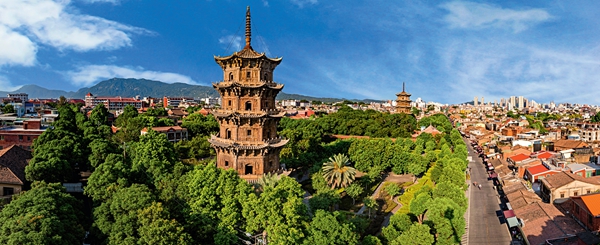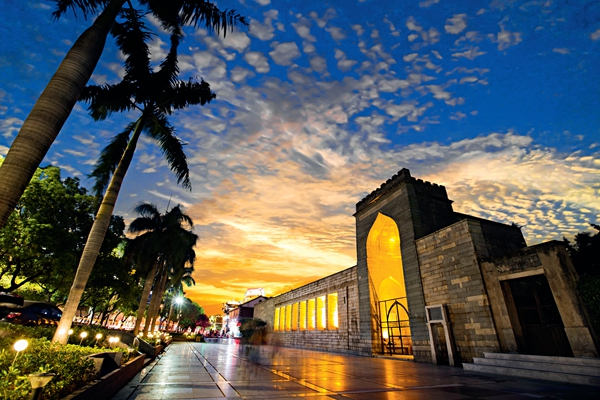Quanzhou, Where the Maritime Silk Road Starts
China Today,September 12, 2017 Adjust font size:
LOCATED in southeast Fujian Province, the coastal city Quanzhou is dotted with rolling hills, valleys, and basins; the Daiyun Mountain extends southwest from the northeast of the city. Throughout its long history, Quanzhou has seen the birth of southern Fujianese culture, and it was one of the first Chinese trade ports opened to the outside world. With scores of scenic spots and historical sites, Quanzhou has been affirmed by UNESCO as the starting point of the Maritime Silk Road.
A Culture with Far-reaching Influence
Southern Fujianese culture is also called Minnan culture (in Chinese, Min is the shortened name for Fujian, and nan means south). It originated in Quanzhou and has been cultivated together with the people of southern Fujian. With the Minnan dialect as its carrier and maritime culture at its core, Minnan culture constitutes an important part of the greater Chinese culture; its sphere of influence reaching Fujian, Zhejiang, Guangdong and Taiwan, and even as far as Singapore and other Southeast Asian countries.

Two ancient stone towers in the Kaiyuan Temple of Quanzhou City. Chen Yingjie
In the Han (206 BC-AD220) and Jin (265-420) dynasties, large numbers of ethnic Han people from the central plains of China migrated south to Quanzhou. Hence the culture of the central plains began to merge with that of southern Fujian, thus precipitating the formation of Minnan culture.
Quanzhou saw a significant population increase and economic development during the Song (960-1279) and Yuan (1206-1368) dynasties, and the city thus became the starting point of the Maritime Silk Road and an important port in the East. As Arabs and Persians arrived in Quanzhou for trade, they enriched the Minnan culture with their own Islamic traditions.
During the Ming (1368-1644) and Qing (1616-1911) dynasties, European businessmen and missionaries brought Western culture to Quanzhou, further boosting local cultural development. After thousands of years of encounters and integration with various peoples, a diversified cultural system fusing agricultural civilization, maritime trade, and religious culture took shape.

An aerial view of Quanzhou. Chen Yingjie
Minnan dialect, one of China’s eight major dialects, originated in Quanzhou, but its popularity has gone far beyond its geographical homeland. In Taiwan, apart from that in the Gaoshan ethnic group settlements, Minnan dialect can be heard almost everywhere. In Singapore,70-80 percent of the local population can speak or understand it. More than 40 million people across the world are proficient in it.
Architecture is an important proponent and embodiment of a culture. In Quanzhou, the most typical of traditional architectural styles is the ancient cuo (meaning“house” in the local language). These ostentatious and magnificent ancient cuos feature red bricks and tiles, white stone bases, roofs that are sunken in the middle and tipped with raised, fork-tailed ridges at either end, and embellished with exquisite stone and wood carvings. The larger residences, fashioned in the traditional style in modern and contemporary times, have mostly been built by eminent figures, as well as overseas Chinese and business tycoons to house several generations of their family.
Another of Quanzhou’s distinctive local architectural styles is the oyster shell house, whose walls are inlaid with oyster shells. The greyish white shells contrast beautifully with the mottled granite and red bricks. Together they create a stunning sight to behold. These oyster shell houses are mainly distributed throughout the Xunpu, Fashi, Dongmei, and Jinqi neighborhoods, in Fengze District of Quanzhou City with Xunpu having the densest cluster of oyster shell houses.
“Fanzai” is a term used by Quanzhou people for the buildings that combine foreign and traditional Chinese architectural elements, mostly built during the Republic of China (1912-1949) period by overseas Chinese who returned from Southeast Asia. Fanzai buildings were mostly built with construction materials imported from Southeast Asia. Absorbing the merits of both traditional Minnan residential buildings and Southeast Asian architectural styles, these Fanzai buildings feature distinct designs, exquisite pieces of art work, marvelous carvings, colorful paintings, brick patterns, and sculptures.
The Maritime Silk Road
Since ancient times, China has engaged in exchanges and trade with other countries of the world. Two thousand years ago, the ancient Chinese developed a trade route that started in China’s southeast coastal area, passing through the Indo-Chinese Peninsula, and then crossing the Indian Ocean and the Red Sea until finally reaching East Africa and Europe.

The Qingjing Mosque under the sunset glow. Chen Yingjie
Until the 8th century, this maritime trade route had mainly been used for the transportation of silk products. Therefore, it is called the Maritime Silk Road. Later, as a result of various reasons including wars, the Maritime Silk Road replaced the overland route and became the main channel for China’s trade and cultural exchanges with foreign countries.
As China’s shipbuilding and navigation techniques improved significantly, such as through the invention of the compass and its application in sailing, China’s commercial ships began voyaging even further. China then developed direct trade links with more than 60 countries and regions, propelling the development of the countries located along the trade route.
During this period, China mainly exported silk products, porcelain, tea, and iron and copper wares. It imported spices, flowers and plants, as well as rare artifacts for royal use. The Maritime Silk Road then came to be known as the maritime porcelain or spice road.

The Luoyang Bridge, an ancient architectural masterpiece in Quanzhou.
Quanzhou’s exchanges with neighboring countries can be traced back to the6th century. In the 13th century, the city had evolved into China’s busiest port, enjoying the same reputation as Egypt’s port of Alexandria. Quanzhou had trade links and cultural exchanges with nearly 100 countries and regions, including Southeast Asia, Persia, Arabia, and Africa. It exported porcelain, silk, tea and iron, imported spices such as pepper, medicinal materials, and pearls via the maritime trade route.
The Travels of Marco Polo documents the Italian traveler’s 17-year stay in China. Before he left the country he visited Quanzhou, as the last stop of his journey. He was deeply impressed by its burgeoning trade, abundant natural resources and friendly people. He wrote,“There is a port along Citongcheng (the ancient name of Quanzhou), famed for its bustling shipyards. Hordes of businessmen gather there with bountiful products available. Delicate Dehua porcelain is sold at reasonable prices. A Venice silver coin can buy you eight porcelain cups.”
Quanzhou’s shipbuilding technology also surprised Marco Polo. As one of the major shipbuilding bases in the Song and Yuan dynasties. Some of the sturdiest and most advanced ships in the world, known for their stability, seaworthiness, and safety facilities stored in water-tight compartments were built in Quanzhou. The travel book states,“The Khan issued another order to build 14 ships, each one equipped with four masts, able to sail long distances… Among them at least four or five ships can accommodate 250-260 sailors.”
Today, the annual cargo throughput of Quanzhou Port has exceeded 100 million tons, and more than 80 shipping routes are in operation.
The Anxi Tea Culture
China is the birthplace of tea and the cradle of tea culture. Fujian, a coastal province in Southeast China, is an ideal place for growing tea, thanks to its warm, humid climate. Locally produced oolong tea is one of the most distinctive varieties of Chinese tea; Tieguanyin, produced in Anxi County of Quanzhou City, is the finest variety of oolong tea.
Anxi County, 53 km west of Quanzhou’s downtown area, is the birthplace and main manufacturing area of Tieguanyin. Also known as China’s tea capital, Anxi enjoys year-round clement weather. The county is surrounded by verdant ridges and peaks, rippled with clear creeks that wind their way through them.
The history of Anxi’s tea production goes back 1,000 years. While cultivating the famous Tieguanyin, local tea farmers have formed a complete set of unique techniques on tea cultivation and brewing, as well as tea appreciation and tasting, thus shaping distinct local folk tea customs and the ancient and splendid Anxi tea culture.
The most wonderful folk custom here is Doucha (tea game). It is an interesting and challenging activity, and a winner will be crowned at the end. In ancient times, Doucha was a widely practiced social activity, and was usually held in three separate places: some Doucha were carried out in tea processing workshops for participants to taste and evaluate the fresh product; some were held in the downtown tea shops among tea sellers and lovers, with the aim of soliciting business and attracting customers; and finally, scholars and officials also held their own refined version of Doucha, by leisurely savoring the tea in famous scenic spots and officials’ mansions.
In Anxi, people obsessed with Doucha include expert tea makers, ordinary tea lovers, and tea dealers. Whenever new tea comes into season, Doucha activities can be seen everywhere from small yards in tea grower’s homes, to teahouses and teashops, as well as in competition venues where organizers search for“the King of Tea.” A group of experts gather together around several old-fashioned square tables, sitting on long wooden benches. Dozens of teacups arranged in front of them emanate a wonderful aroma. This is the joy of drinking tea.
The more formal and more serious Doucha is usually organized by different levels of the government, and is called the Competition for the King of Tea. In the competition, participants first hand in a share of their own tea leaves as per requirement. The organizing committee invites tea experts as judges to evaluate the tea, taking into consideration such factors as appearance, color, fragrance, and flavor, with a notary supervising the entire process. The winner will don a crown to match his/her red robe and broad silk belt tied around the waist, with a trophy in his/her hands. The winner will also be carried up in a sedan chair, with a parade consisting of hundreds of people following the crowned champion. The procession will pass through major streets and lanes of the city.